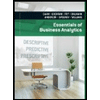
Financial Accounting-w/cd-package
3rd Edition
ISBN: 9780131060876
Author: REIMERS
Publisher: PEARSON
expand_more
expand_more
format_list_bulleted
Concept explainers
Question
Chapter 2, Problem 19SEB
To determine
Explain the manner in which these
Expert Solution & Answer
Want to see the full answer?
Check out a sample textbook solution
Students have asked these similar questions
? ? Financial accounting question
The income statement of a merchandising company includes Cost of Goods Sold (COGS) and gross profit, which are not found on a service company’s income statement. This is because merchandising companies sell physical products, while service companies provide intangible services. Service company income statements are simpler, usually showing revenue from services minus operating expenses like salaries, rent, and supplies. In short, the main difference is that merchandising firms track product costs and gross profit, while service companies do not.
Respond to this post. agree or disagree
Please give me true answer this financial accounting question
Chapter 2 Solutions
Financial Accounting-w/cd-package
Ch. 2 - Prob. 1YTCh. 2 - Prob. 2YTCh. 2 - Is prepaid insurance an expense or an asset?...Ch. 2 - Prob. 4YTCh. 2 - Give an example of the matching principle from the...Ch. 2 - What is the difference between cash basis and...Ch. 2 - Prob. 7YTCh. 2 - What is GAAP? What is IFRS?Ch. 2 - Prob. 2QCh. 2 - Prob. 3Q
Ch. 2 - Prob. 4QCh. 2 - Prob. 5QCh. 2 - What are the four basic financial statements?Ch. 2 - Which financial statement pertains to a single...Ch. 2 - Prob. 8QCh. 2 - Prob. 9QCh. 2 - Prob. 10QCh. 2 - Prob. 11QCh. 2 - Prob. 12QCh. 2 - What does recognize revenue mean in accounting?Ch. 2 - Prob. 14QCh. 2 - What is an accrual? What is a deferral?Ch. 2 - Must a company collect the money from a sale...Ch. 2 - What is the cost of goods sold?Ch. 2 - Explain the difference between cash basis...Ch. 2 - Prob. 19QCh. 2 - Prob. 20QCh. 2 - Prob. 21QCh. 2 - Prob. 1MCQCh. 2 - Prob. 2MCQCh. 2 - Prob. 3MCQCh. 2 - Prob. 4MCQCh. 2 - Prob. 5MCQCh. 2 - Prob. 6MCQCh. 2 - Prob. 7MCQCh. 2 - Prob. 8MCQCh. 2 - Prob. 9MCQCh. 2 - Prob. 10MCQCh. 2 - Elements of the financial statements. (LO 3). For...Ch. 2 - Prob. 2SEACh. 2 - Prob. 3SEACh. 2 - Prob. 4SEACh. 2 - Prob. 5SEACh. 2 - Prob. 6SEACh. 2 - Cash versus credit sales. (LO 3, 4). Company A had...Ch. 2 - Prob. 8SEACh. 2 - Prob. 9SEACh. 2 - Prob. 10SEACh. 2 - Prob. 11SEBCh. 2 - Prob. 12SEBCh. 2 - Prob. 13SEBCh. 2 - Prob. 14SEBCh. 2 - Prob. 15SEBCh. 2 - Prob. 16SEBCh. 2 - Prob. 17SEBCh. 2 - Prob. 18SEBCh. 2 - Prob. 19SEBCh. 2 - Prob. 20SEBCh. 2 - Prob. 21EACh. 2 - Prob. 22EACh. 2 - Prob. 23EACh. 2 - Balance sheet and income statement transactions....Ch. 2 - Prob. 25EACh. 2 - Prob. 26EACh. 2 - Prob. 27EACh. 2 - Prob. 28EACh. 2 - Elements of the financial statements. (LO 3). The...Ch. 2 - Prob. 30EBCh. 2 - Elements of the financial statements. (LO 3)....Ch. 2 - Prob. 32EBCh. 2 - Prob. 33EBCh. 2 - Prob. 34EBCh. 2 - Prob. 35EBCh. 2 - Current ratio. (LO 5). The following data was...Ch. 2 - Prob. 37PACh. 2 - Prob. 38PACh. 2 - Prob. 39PACh. 2 - Prob. 40PACh. 2 - Prob. 41PACh. 2 - Prob. 42PBCh. 2 - Prob. 43PBCh. 2 - Prob. 44PBCh. 2 - Prob. 45PBCh. 2 - Prob. 46PBCh. 2 - Prob. 1FSACh. 2 - Prob. 2FSACh. 2 - Prob. 3FSA
Knowledge Booster
Learn more about
Need a deep-dive on the concept behind this application? Look no further. Learn more about this topic, accounting and related others by exploring similar questions and additional content below.Similar questions
- Financial accounting questionarrow_forwardPlease solve and show work for general accounting questionarrow_forwardCarlisle Manufacturing, which uses a calendar year, purchased a machine for $60,000 on January 5, 2015. It estimates the machine will have a useful life of 10 years and a $6,000 residual value. The machine is expected to produce 250,000 units during its useful life. The actual number of units produced were 22,000 during 2015, 31,000 during 2016, 24,000 during 2017, and 30,000 during 2018. Using the straight-line method, what is the book value at December 31, 2017?arrow_forward
- What is your capital gains yield on this investment for this financial accounting question?arrow_forwardWhat is the weighted average cost per unit for July on these general accounting question?arrow_forwardArden Manufacturing uses process costing. At the beginning of March, there were 1,200 units in beginning inventory, 45% complete. During the month, 9,500 units were started. At the end of March, 600 units remained in ending inventory, 80% complete. How many units were completed during the month of March?arrow_forward
- A warehouse with an appraisal value of $145,320 is made available at an offer price of $168,750. The purchaser acquires the property for $40,500 in cash, a 90-day note payable for $26,500, and a mortgage amounting to $62,900. What is the cost basis recorded in the buyer's accounting records to recognize this purchase? a) $168,750 b) $145,320 c) $129,900 d) $121,460arrow_forwardEvergreen Manufacturing uses a job-order costing system. The company estimates: Total direct labor hours for the year: 120,000 • Fixed manufacturing overhead: $600,000 Variable overhead rate: $2.50 per direct labor hour Job 307 details: Direct labor hours for the job: 80 Direct labor cost: $6,000 • Direct materials used: $950 What is the total job cost for Job 307?arrow_forwardDo fast answer of this question financial accountingarrow_forward
arrow_back_ios
SEE MORE QUESTIONS
arrow_forward_ios
Recommended textbooks for you
 Essentials Of Business AnalyticsStatisticsISBN:9781285187273Author:Camm, Jeff.Publisher:Cengage Learning,
Essentials Of Business AnalyticsStatisticsISBN:9781285187273Author:Camm, Jeff.Publisher:Cengage Learning,

Essentials Of Business Analytics
Statistics
ISBN:9781285187273
Author:Camm, Jeff.
Publisher:Cengage Learning,
The ACCOUNTING EQUATION For BEGINNERS; Author: Accounting Stuff;https://www.youtube.com/watch?v=56xscQ4viWE;License: Standard Youtube License